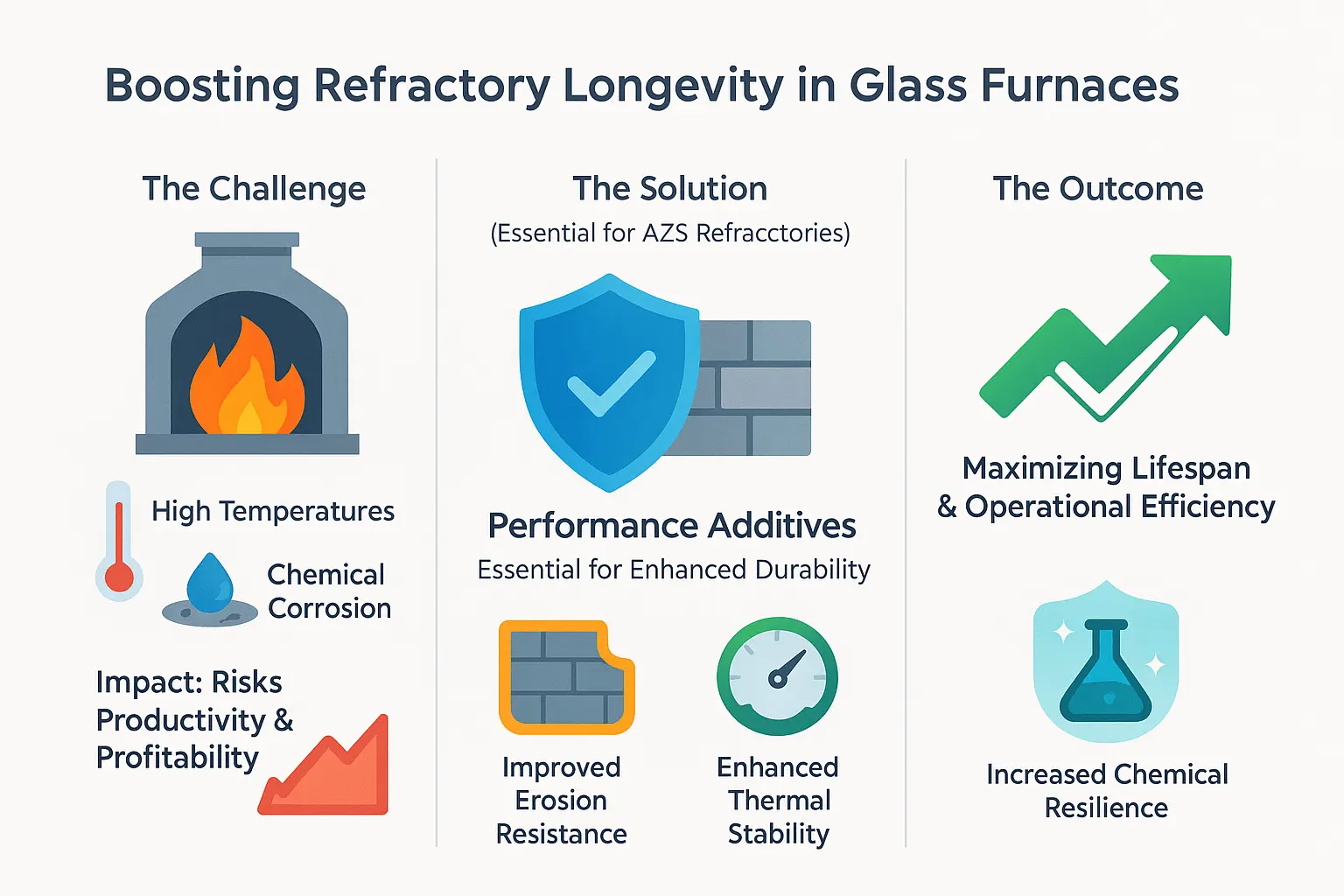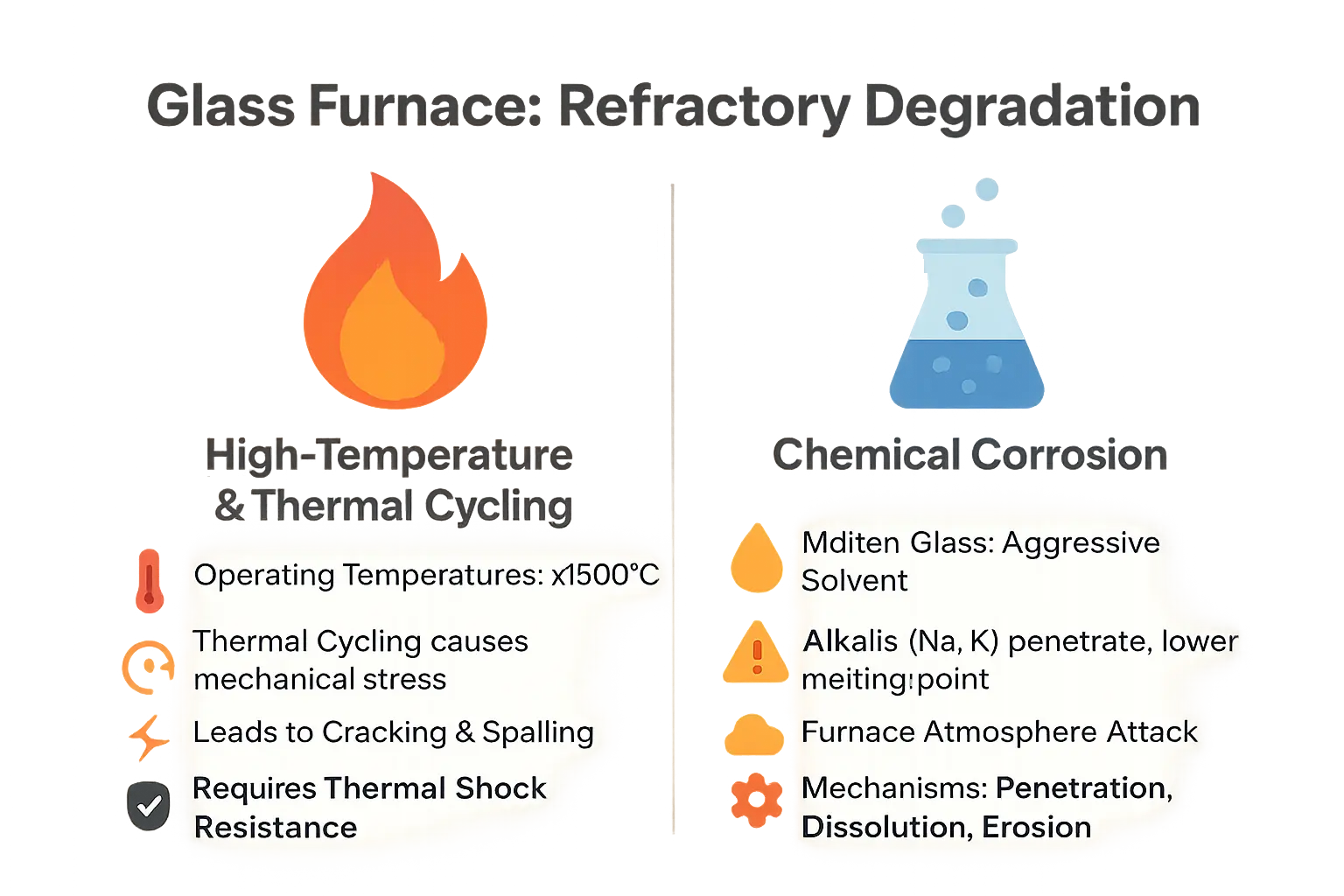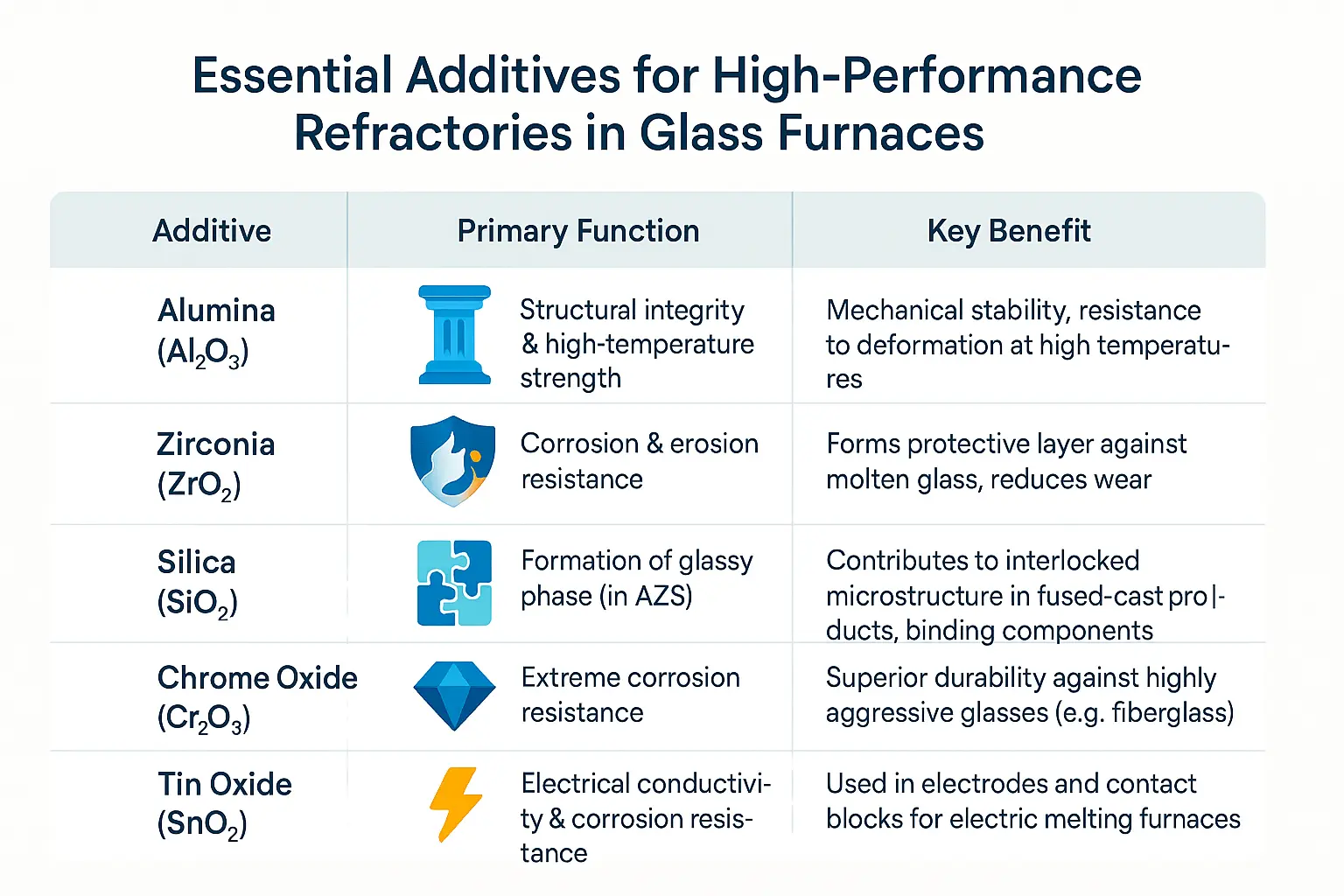Are your refractory linings failing too soon in glass furnaces, risking costly downtime and safety hazards? In the relentless environment of glass furnaces—where thermal cycling, chemical corrosion, and thermal shock resistance collide—even the most robust refractories face premature degradation. This article uncovers how precision-engineered performance additives, like zirconia’s protective vitreous layers and alumina’s high-temperature stability, are transforming additives durability refractories glass furnaces. Discover how tailored AZS refractories (Alumina-Zirconia-Silica), combined with fused-cast techniques, combat erosion, resist alkali penetration, and extend service life by up to 40%, offering unmatched resilience against molten glass and furnace atmospheres.
- Enhancing refractory longevity in glass furnaces: the critical role of additives
- The Demanding Environment Inside a Glass Furnace
- Key performance additives and their impact on refractory properties
- The Science Behind Corrosion Resistance In Zirconia-Based Refractories
- Manufacturing Techniques And Their Influence On Additive Effectiveness
- Strategies for maximizing the lifespan of refractory linings
- Partnering for optimal furnace performance and durability
Enhancing refractory longevity in glass furnaces: the critical role of additives
Durability defines success for refractories in glass furnaces, where temperatures exceed 1650°C and corrosive vapors attack materials. Without performance additives, AZS (Alumina-Zirconia-Silica) bricks would fail rapidly. Why do 92% of operators report reduced downtime after optimizing additives? These materials combat erosion, thermal stress, and chemical corrosion through precise engineering.
Zirconia’s phase transformation at 1170°C creates microcracks that absorb thermal stress, extending service life by 20% in sintered AZS formulations. The glassy phase binding crystalline structures is equally vital – an optimized composition resists molten glass penetration 40% more effectively than traditional AZS. Computational modeling confirms three strategies: eutectic phase control, borosilicate coatings, and microstructural engineering to reduce porosity.
Proper additive balance is critical. Excessive glassy phase increases solubility, while insufficient zirconia weakens thermal shock resistance. Real-world applications show optimized AZS bricks like VISTA C form protective nepheline layers against alkali attack. For industries where refractory failures cost $2M+ annually, additive science isn’t just beneficial – it’s mission-critical for furnace longevity and operational efficiency.


The Demanding Environment Inside a Glass Furnace
High-Temperature Exposure and Thermal Cycling
Glass furnaces operate under extreme high-temperature conditions, often exceeding 1500°C. This intense heat creates significant thermal stress on refractory materials in critical zones like melter walls and forehearth structures. For instance, thermal stress can cause cracks in AZS bricks near feeder blocks where temperature gradients reach 800-1000°C across 200mm thickness.
Thermal cycling—repeated heating and cooling cycles—generates differential expansion within the refractory matrix. A temperature gradient across AZS bricks can create stress surpassing material strength, leading to microfractures that compromise structural integrity. These microcracks propagate under mechanical loads, accelerating wear in areas like crown blocks exposed to flame impingement.
Spalling becomes a critical failure mode when thermal gradients exceed the material’s thermal shock resistance. This causes surface flaking or breakaway, reducing furnace efficiency. The thermal shock resistance of AZS bricks depends on ZrO₂ optimization, where 33-42% concentration creates a balanced microstructure with eutectic phases that absorb thermal stress. These phases act as crack arresters, limiting fracture propagation through deflection and bridging mechanisms.
Chemical Corrosion from Molten Glass
Molten glass acts as a powerful solvent against oxide-based refractories. Alkalis like sodium and potassium penetrate through pores, lowering the melting point through fluxing reactions. For example, soda-lime glass infiltration can reduce the refractory’s softening point by 250-300°C, creating a friable reaction layer prone to erosion.
This chemical corrosion creates a weakened vitreous layer dissolving into the glass batch, contaminating the final product with metallic inclusions. The dissolution process accelerates with temperature increases, following kinetic principles where reaction rates double every 50°C.
Key degradation mechanisms include penetration (glass infiltration through capillary action), dissolution (chemical breakdown at reaction interfaces), and erosion (mechanical wear from glass flow). These processes intensify above 1450°C, where viscosity drops below 100 Pa·s, enhancing glass penetration into refractory microstructure.
AZS bricks with ZrO₂ content between 33-42% show enhanced resistance. The vitreous phase acts as a diffusion barrier, though SiO₂ remains vulnerable. Zirconium-based refractories (AZS, HZFC) excel with high density minimizing porosity below 1.5%, preventing deep glass penetration beyond 500μm.
High ZrO₂ concentration (50-60%) improves chemical resilience against soda-lime glasses by forming protective ZrSiO₄ layers. These layers act as physical barriers, reducing attack rates by 35-40% through reduced wettability and slower diffusion kinetics. Understanding these degradation mechanisms ensures additives address both thermal shock resistance and chemical corrosion to maximize AZS brick durability in glass furnace applications.
Key performance additives and their impact on refractory properties
Alumina (Al₂O₃): the structural backbone
Alumina forms the core of high-alumina refractories, maintaining structural integrity at temperatures exceeding 1700°C through its corundum phase. With glassy phase content below 1% in alpha-corundum bricks, it minimizes chemical reactions with molten glass, preventing iron-related discoloration (<0.3% Fe₂O₃). These materials excel in superstructures and regenerators, combining compressive strengths >100 MPa with thermal cycling resistance (≥30 cycles at 1100°C). Beta-alumina variants offer superior vapor-phase stability for specialized zones but are limited to non-load-bearing applications due to lower mechanical strength. Mullite-corundon composites further enhance thermal shock resistance by integrating 82%+ Al₂O₃ with optimized porosity.
Zirconia (ZrO₂): the champion of corrosion resistance
Zirconia’s corrosion resistance stems from its <1% solubility in silicate melts, creating a protective aluminosilicate layer at the glass-refractory interface. In AZS refractories, skeletal ZrO₂ particles (40–60% content) resist detachment during glass flow, maintaining dimensional stability. The martensitic phase transformation (monoclinic ↔ tetragonal) under stress generates microcracks that absorb 35–40% more energy than conventional materials, extending service life in throat blocks and melter floors. Fused zirconia, engineered with controlled cooling to limit pore connectivity (<100 nm), resists aggressive soda-lime glass corrosion at 1500–1600°C while maintaining thermal expansion <5×10⁻⁶/K.
Specialized additives for enhanced performance
Chrome oxide (Cr₂O₃) delivers triple corrosion resistance in fiber glass furnaces by forming Cr³⁺-rich layers that resist alkali attack. However, its use is restricted to non-transparent glass applications due to green discoloration risks. Tin oxide (SnO₂) enables electric furnace electrodes with 10⁴ S/m conductivity and oxidation resistance up to 1800°C. STANNEX™ electrodes, produced via 630T isostatic pressing without recycled materials, ensure 99.9% purity through individual testing. Silica’s role in AZS refractories extends beyond matrix formation—it facilitates mullite-zirconia interlocking during casting, reducing thermal expansion mismatch by 25% in fluctuating conditions. This microstructural engineering explains AZS’s <0.5 mm/year wear rates in aggressive glass compositions.
| Additive | Primary Function | Key Benefit |
|---|---|---|
| Alumina (Al₂O₃) | Structural integrity and high-temperature strength | Provides mechanical stability and resistance to deformation at high temperatures |
| Zirconia (ZrO₂) | Corrosion and erosion resistance | Forms protective layer against molten glass, reducing wear rate by 35–40% |
| Silica (SiO₂) | Formation of glassy phase in AZS | Creates interlocked microstructure in fused-cast products |
| Chrome Oxide (Cr₂O₃) | Extreme corrosion resistance | Delivers 3× higher durability against special glasses like fiber glass |
| Tin Oxide (SnO₂) | Electrical conductivity and corrosion resistance | Enables reliable performance in electric furnace electrodes and contact blocks |
Image: 
AZS refractories combine zirconia’s corrosion resistance with silica’s microstructural cohesion, achieving wear rates below 0.5 mm/year. This synergy ensures materials exceed 1800°C refractoriness while maintaining thermal expansion <5×10⁻⁶/K, critical for minimizing downtime in glass furnace linings. The controlled vitrification during AZS casting creates a skeletal framework where ZrO₂ particles (>40%) act as erosion barriers, while the aluminosilicate matrix (<20% glassy phase) prevents crack propagation under thermal cycling.
The Science Behind Corrosion Resistance In Zirconia-Based Refractories
Thermomechanical Properties And Microstructure
Fused-cast AZS refractories typically contain 43–50% Al₂O₃, 33–42% ZrO₂, and 13–20% SiO₂, with a vitreous matrix making up 20–30% of the structure. This microstructure features interlocked zirconia (ZrO₂) crystals and eutectic Al₂O₃-ZrO₂ domains embedded in siliceous glass. The ZrO₂ phase undergoes a phase transformation from tetragonal to monoclinic during cooling, creating microcracks that absorb thermal stress. Stabilizers like yttria (Y₂O₃) maintain the tetragonal phase, preventing uncontrolled expansion. This controlled transformation enhances fracture toughness, a critical factor for glass furnace linings operating at 1,600–1,800°C.
The vitreous matrix binds zirconia and alumina crystals, acting as a thermal buffer and chemical barrier. However, its low viscosity at high temperatures can lead to exudation, creating porosity that accelerates corrosion. Dense, fine-grained microstructures with minimal pores (<1%) resist glass infiltration better. Mullite formation, while beneficial in some refractories, can reduce corrosion resistance in AZS due to its lower melting point (1,840°C). Optimizing eutectic phase content and grain refinement during casting improves durability by reducing interfacial reaction zones.
Thermodynamic And Kinetic Principles Of Corrosion
Corrosion in glass furnaces stems from thermodynamic instability between refractory components and molten glass. The system minimizes free energy by dissolving refractory oxides into the melt. Kinetic factors—temperature, flow dynamics, and glass composition—govern reaction rates. For instance, a 50°C increase (e.g., from 1,400°C to 1,450°C) can double the corrosion rate of chromia-rich refractories like Monofrax® K-3. Alkali-rich glasses (e.g., high Na₂O content) exacerbate silica dissolution, while silica-rich melts form protective layers, slowing degradation.
The multi-stage process of refractory corrosion includes:
- Vapor Phase Attack: Volatile alkalis infiltrate pores, reacting with silica in the vitreous matrix to form low-viscosity phases. This weakens the structure, enabling deeper penetration.
- Reaction And Alteration: Alkalis destabilize the Al₂O₃-ZrO₂ eutectic, generating soluble sodium aluminosilicates. This phase alteration accelerates material loss.
- Grain Dissolution: Zirconia and alumina grains dissolve into the reactive melt. ZrO₂, though highly stable, dissolves via Zr⁴⁺-Na⁺ ion exchange, a process intensified by oxidative atmospheres.
- Erosion And Removal: Convective flow in the melt physically erodes weakened layers, exposing fresh refractory to attack. This cycle is amplified in zones with turbulent glass flow.
Microstructural flaws, such as interconnected pores or uneven phase distribution, act as initiation sites for these mechanisms. For example, a 10% increase in porosity can reduce refractory lifespan by up to 30%. Redox conditions also play a role: oxidative atmospheres increase corrosion rates by 1.8–2.8 times compared to reducing environments. Advanced casting techniques, such as directional solidification, minimize these flaws, enhancing performance under extreme thermal and chemical stress.
Manufacturing Techniques And Their Influence On Additive Effectiveness
Fused-Cast Versus Sintered Refractories
Performance additives in AZS bricks depend on manufacturing alignment. Fused-cast refractories are produced by melting raw materials in electric arc furnaces at ~2000°C, then casting into molds. This forms a dense, interlocked structure with minimal porosity, ideal for molten glass contact. Additives like zirconia (ZrO₂) thrive by minimizing corrosion pathways. For example, AZS bricks with 33–41% ZrO₂ excel in direct glass contact zones, such as in display glass furnaces where chemical stability is critical.
Sintered refractories use pressed powders fired below melting points, resulting in higher porosity and lower density. They suit non-contact areas like furnace superstructures. While cost-effective, their porous structure limits additive effectiveness in harsh conditions. Zirconia-based additives often aggregate in sintered materials, creating stress points that accelerate erosion under thermal shock. The sintering process requires precise control to avoid uneven additive distribution.
- Fused-Cast: Low porosity, high density, interlocked crystals—ideal for glass-contact zones.
- Sintered: Higher porosity, lower cost, suited for non-contact areas but less effective for additive integration.
The Future: Emerging Manufacturing Methods
Additive manufacturing (AM) enables graded compositions and tailored microstructures, addressing localized wear in glass furnaces. Functionally graded materials (FGMs) via directed energy deposition improve thermal-shock resistance and reduce cracking. For example, W-WC-Nb coatings on titanium substrates show crack-free microstructures during deposition through controlled substrate integration.
Challenges include managing high-melting-point materials and oxygen-induced embrittlement. Strategies like substrate preheating and niobium alloying can mitigate these issues. AM supports in-situ carbide formation, such as titanium carbide, bypassing traditional pre-processing hurdles. Though niche, AM’s potential to customize material behavior across furnace zones could redefine refractory durability by combining multiple high-performance properties for glass production.
Strategies for maximizing the lifespan of refractory linings
Best practices for installation and initial heat-up
Even high-quality refractories can fail prematurely if installation isn’t executed correctly. Ensuring best practices during setup is critical for long-term performance in glass furnaces. Proper joint construction requires minimizing horizontal joints in glass-contact zones to prevent penetration. Using refractory mortar specifically matched to brick composition prevents chemical interactions that weaken structural integrity. Incompatible mortars create weak points where molten glass attacks the lining, accelerating erosion.
Material compatibility extends beyond mortar selection. Transition bricks must separate dissimilar refractories to avoid adverse chemical reactions at interfaces. For AZS brick applications, this prevents zirconia destabilization from alkali migration between material boundaries. Critical zones demand premium-grade AZS, while less-stressed areas can use standard compositions to balance cost and performance.
A controlled initial heat-up program ensures gradual thermal expansion, preventing cracking from stress concentrations. Slow ramping (e.g., 20-30°C/hour up to 600°C) allows binder burnout and phase transformations to complete without creating internal fractures. This critical phase directly impacts service life by eliminating residual stresses before full production begins.
Predictive maintenance and advanced monitoring
Modern glass furnaces benefit from predictive maintenance strategies that detect issues before failures occur. These approaches combine non-destructive testing (NDT) with digital tools for proactive intervention. Computational modeling becomes particularly valuable for AZS brick applications, simulating molten glass flow patterns to identify high-erosion zones before brick installation.
Key monitoring techniques include:
- Infrared Thermography: Identifies hot spots indicating refractory thinning through real-time thermal imaging
- Endoscopic Visual Inspection: Uses high-temp cameras to assess wear patterns during operation
- Laser Measurement: Creates precise 3D maps of internal furnace profiles during rebuilds
- Computational Modeling: Simulates glass flow and thermal gradients to forecast wear zones
Companies like PaneraTech offer digital furnace management systems using AI-driven twin modeling. Their Digital Furnace Management (DFM) platform detects glass penetration 1-3 years before visual indicators appear. FM Global now recommends this sensor technology as a standard risk mitigation strategy.
Thermal stress remains a persistent threat, but monitoring systems enable precise temperature gradient control. For AZS bricks, maintaining uniform heating rates below 35°C/hour during operation reduces microcrack propagation. When combined with mortar compatibility protocols, this extends lining longevity compared to conventional maintenance approaches.
Partnering for optimal furnace performance and durability
Performance additives like zirconia (ZrO₂) in AZS refractories enhance durability in glass furnaces by creating a skeletal microstructure that traps corrosion products, reducing particle loss. The aluminosilicate glassy matrix binds crystals, prevents thermal cracking, and blocks reactive molten glass compounds.
AZS bricks’ corrosion resistance comes from their fused cast production, ensuring high density and low porosity. This structure limits glass penetration into microcracks, while alumina-zirconia eutectic domains boost thermal stability. These traits make AZS essential for high-stress areas like furnace bottoms, where temperatures exceed 1500°C.
Durability requires a holistic strategy: aligning material selection with thermal cycling, chemical exposure, and mechanical stress. Precision in design, installation, and maintenance minimizes downtime, extending refractory lifespan in glass production.
MXS Refractories offers tailored solutions for glass furnaces, leveraging expertise in performance additives and material science. Their AZS systems optimize corrosion resistance and thermal resilience, supported by end-to-end services—from design to on-site supervision—for reliable, long-term furnace performance.
By prioritizing durability, MXS Refractories enables sustainable, high-output glass manufacturing. Their custom strategies balance technical precision with cost efficiency, addressing unique furnace demands for lasting results.
Refractory durability in glass furnaces hinges on advanced performance additives like zirconia in AZS refractories, which enhance corrosion resistance and thermal stability. By integrating material science, precise manufacturing, and predictive maintenance, industries can optimize lifespan. Partnering with experts like MXS Refractories ensures custom refractory solutions, merging innovation and operational excellence for unmatched furnace performance.
